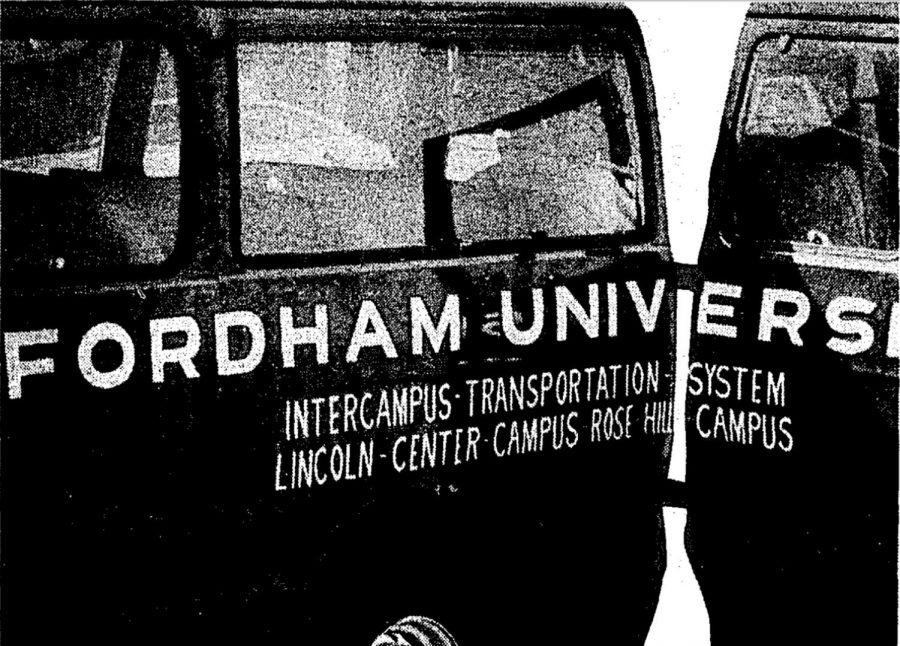40 Years of the Rambling Ram Van
THE OBSERVER ARCHIVES
The Ram Van has evolved alongside the Lincoln Center campus; what started as an experiment has now turned into a pillar of student life.
December 4, 2019
Forty years ago this semester, a hallmark of the Fordham experience was born: the Ram Van. Fordham students have complained about the Ram Van since its inception in 1979 — if you’ve ever taken our intercampus transportation, you know about the unpredictable commute, the bumpy New York roads and the $3.50 price tag, 75 cents more per trip than the subway. Ram Van drivers and passengers over the years have captivating stories to report from their trips, many of which can be found in The Observer and The Ram archives.
The first Ram Van, christened Ram Van I, hoped to embark on its maiden voyage from Rose Hill to Lincoln Center on Sept. 17, 1979, at 11:30 a.m. However, due to insurance issues the blessed passage didn’t start until Oct. 1, 1979. Most of its early trips held about five passengers, and there was only one van that went from Rose Hill to Lincoln Center and back; no vans would run simultaneously in either direction. For the first year, the Ram Van cost passengers 50 cents. Joseph McGowan, dean of students at Rose Hill, told The Fordham Ram that “the Ram Van project is ‘strictly experimental.’” Clearly, the experiment has proved to be a success, since it has lasted nearly as long as Fordham Lincoln Center itself.
From 1968 to 1996, Lincoln Center had a different class schedule from Rose Hill, and the Ram Van seemed to cater to students at Rose Hill with the times of vans offered. Before McMahon Hall was built, some Lincoln Center students lived at Rose Hill and took Ram Vans to class every day. These vans favored students who took classes at Rose Hill, so a Lincoln Center student living at Rose Hill needed to take a Ram Van that would make them either hours early or a bit late to class.
In the 1980s, the Ram Van fare increased to $1 and then $1.50 as the subway fare rose to $1. The Ram Van has nearly always been more expensive than the subway, but it is also safer than the D train, especially in the early years of the College at Lincoln Center.
Thomas Waite, College at Lincoln Center ’87, wrote an exposé of the Ram Van with a fake interview with a driver satirizing their jobs: They took different roads to find the most traffic, they played the most annoying music on purpose and they set clocks to make themselves early to Rose Hill and late to Lincoln Center.
The Ram Van also made free trips to and from the Lucerne Hotel, a “residential hotel” on 79th Street and Amsterdam Avenue, for Lincoln Center residents who lived there between 1988 and 1993, when McMahon Hall was built.
By 1988, students from both Rose Hill and Lincoln Center agreed that weekend hours should be added to the Ram Van’s schedule, and Ram Vans ran on Saturdays and Sundays by 1990.
The Ram Van of the 1990s cost $2, and it took students between Manhattan and Rose Hill, as well as to and from off-campus housing in the Belmont and Fordham neighborhoods in the Bronx after some unpleasant altercations with neighborhood residents at Keith Plaza, now a low-income housing project.
The nighttime Ram Van shuttle running every half hour between 10 p.m. and 5 a.m. from Fordham’s Rose Hill campus to the D train station began in 1999 and continues today as a free service for students.
In 1997, students were finally able to sign up for the Ram Van — previously, many students would arrive at the drop-off only to find that all the seats were taken, and they would either take a Ram Van bringing them to Rose Hill late to class or the D train. The sign-up was located at the guard desk in the Lowenstein Building at Lincoln Center. According to The Ram, it only started after “a recent emergency situation, in which a male Ram Van passenger became very ill … caused the University to consider this new sign-in policy,” Gregory Pappas, dean of student affairs at Rose Hill at the time, said.
In 2013, the Ram Van entered the modern era and began to use the online registration service still in use today. That same year, The Ram reported on a record Ram Van trip lasting five hours — passengers were urged to take alternate transportation, but a full van remained, and it took three hours to get from Lincoln Center to the George Washington Bridge, a normally 20-minute drive. The Ram Van had tweeted, “For how long vans are taking coming uptown, you can watch the entirety of The Lord of the Rings: The Return of the King … take the D train.”
Although we may complain about Ram Vans today, it’s not as bad as the first years of the Ram Van, when fewer than 10 trips would be made every weekday, with the five vans they had. Now, the Ram Van has around 45 vans and makes about 150 trips per day.
“It sounds like nothing much has changed with the Ram Van, despite the new paint job and extra tech,” Waite wrote in an email comparing the Ram Vans of the 1980s to those of today. But while Fordham students of any decade find something to complain about in the Ram Van, the mere fact of its continued existence is testament to its necessity and success. Here’s to another 40 years.














Lily Keiley • Dec 17, 2019 at 12:15 am
Thank you for this article!!!!!!!! OMG the Ram Van was and will always be better than the subway and the metro north, I’ll fight anyone on this I stg!!!!!!
Shout out to the amazing ram drivers who drive way better than I ever will and are making more money than most working students.